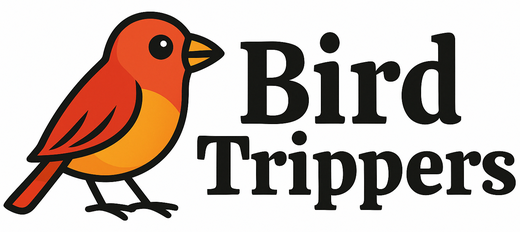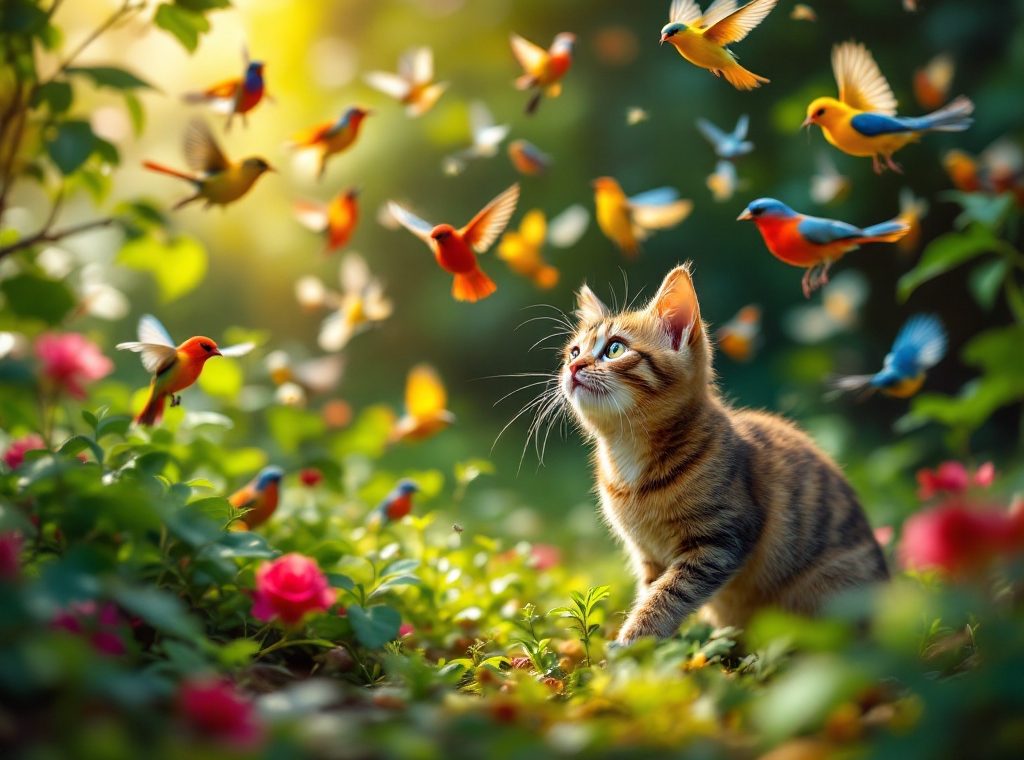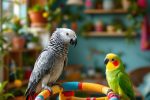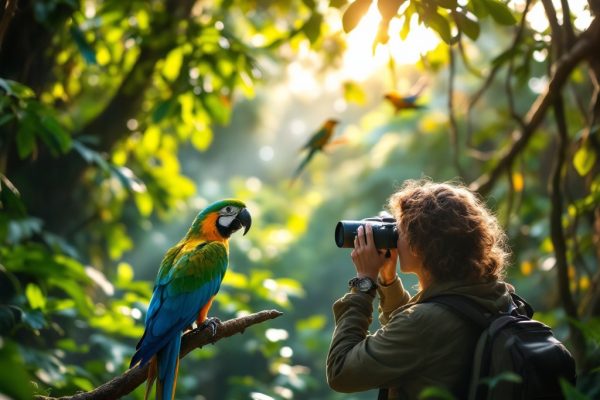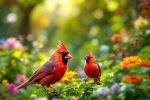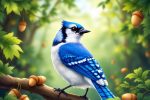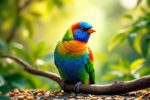Do Cats Eat Birds: Natural Enemies in One House
Did you know that your adorable feline friend’s playful pounce is driven by a powerful predatory instinct? This natural drive, inherited from their wild ancestors, makes cats efficient hunters, but poses a serious threat to birds. Outdoor cats kill billions of birds annually, impacting fragile ecosystems. Discover how you can satisfy your cat’s instincts while protecting birds. Learn about creating safe outdoor spaces, using deterrents, and understanding the impact of cat saliva. Protect your cat and local wildlife – explore solutions for responsible cat ownership today!
Important information
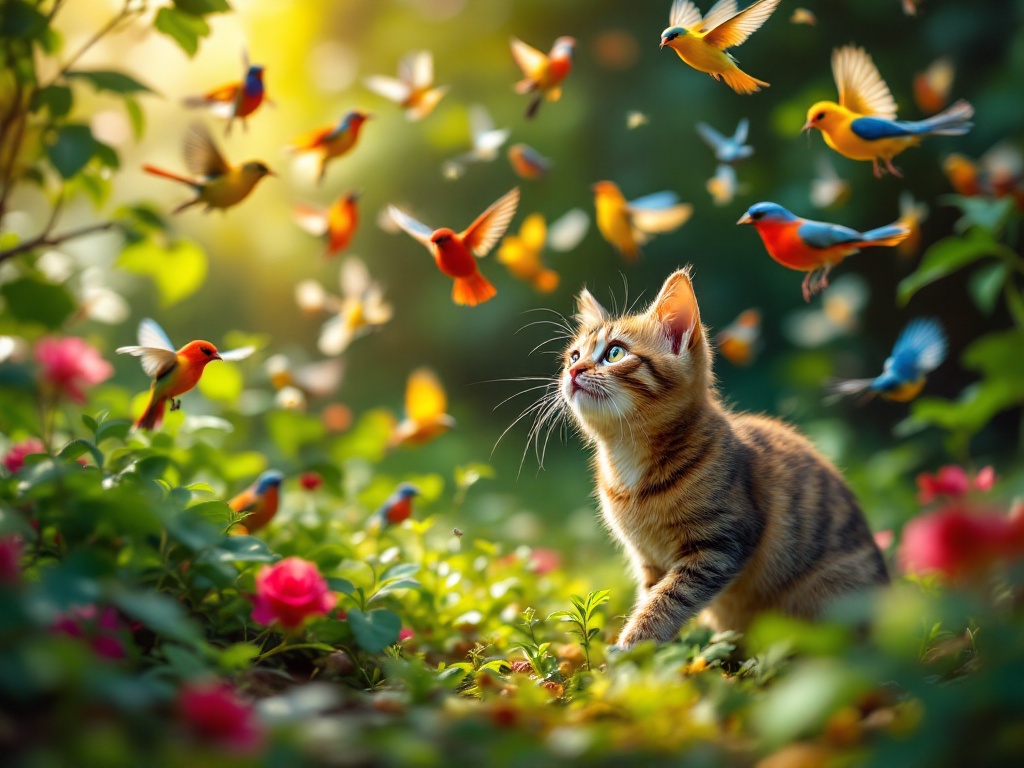
- Cats are natural predators with a strong instinct to hunt birds, driven by their evolutionary history.
- Free-roaming cats kill billions of birds and small mammals annually, significantly impacting ecosystems.
- Cat saliva contains harmful bacteria like *Pasteurella multocida*, dangerous and often fatal to birds.
- Keeping cats indoors, using catios, or supervised outings with a harness and leash protects both cats and birds.
- Breakaway collars with bells can help warn birds of a cat’s presence, potentially reducing predation.
Understanding Cats’ Predatory Instincts
Cats, with hunting deeply ingrained in their DNA, are born predators. This instinct, inherited from their wild ancestors, remains strong even in domesticated felines. House cats stalk, chase, and pounce, often targeting birds triggered by movement and sound. This explains their fascination with feathered creatures. This natural predatory drive reflects their solitary hunting history, yet poses a danger to birds. Outdoor cats can decimate bird populations, impacting local ecosystems. For instance, a cat might easily kill a bird in a backyard setting.
Why Cats Hunt Birds: Instinctive Behavior
Cats are natural hunters, driven by a deep-seated instinct to stalk birds and other small prey. This behavior isn’t simply about sustenance; even well-fed felines continue to hunt. Their ingrained predatory drive stems from their evolution as solitary hunters. This powerful and persistent instinct is simply part of their nature.
The Impact of Cat Saliva on Birds
Cat saliva is dangerous for birds. It contains bacteria, especially *Pasteurella multocida*, which can be fatal even with a minor bite. This bacterium thrives in feline saliva and can quickly kill a bird. A study in the Journal of the American Veterinary Medical Association found *P. multocida* in 70% of infected bird bite wounds. Therefore, keep cats and birds separated.
The Threat of Cats to Bird Populations
Free-roaming cats pose a significant threat to bird populations in the U.S., killing hundreds of millions annually. This predation has even driven some island species to extinction. Ground-nesting birds, those with limited flight, small songbirds, and fledglings are especially vulnerable. This problem is particularly intense in urban and suburban environments, where it noticeably reduces bird numbers.
Domestic Cats and Bird Mortality Rates
Domestic cats pose a significant threat to birds, killing hundreds of millions annually. This makes feline predation a leading human-caused factor in bird mortality. Ground-nesting birds and those with limited flight, such as small songbirds and fledglings, are particularly vulnerable. This predation dramatically affects bird populations and disrupts ecosystems, especially in urban areas. In these areas, native birds already face habitat loss, and the presence of cats introduces another significant threat to their survival.
Free-roaming Cats and Their Impact on Wildlife
Free-roaming cats pose a significant threat to wildlife, killing billions of animals each year. Their impact is devastating, with casualties estimated at 2.4 billion birds and 12.3 billion small mammals annually. This predation dramatically affects numerous species, particularly birds, which are especially vulnerable. The cats’ impact on avian populations disrupts fragile ecosystems and can decimate already vulnerable bird species.
Protecting Birds from Cats
Indoor cats enjoy safety and, in turn, help protect birds from predation. Keeping your cat indoors shields them from hazards like cars, diseases, and parasites. Enrich their indoor environment with toys, climbing structures, and window perches to satisfy their natural instincts.
Protecting Your Cat and Birds
If your cat longs for the outdoors, consider supervised outings or enclosed “catios.” These options offer a safe compromise, protecting both your cat and local birds. Strategically placing bird feeders out of reach and using deterrents can further safeguard birds. Applying reflective tape to windows helps prevent bird collisions.
If Your Cat Catches a Bird
Should your cat catch a bird, swift intervention is crucial. Gently retrieve the bird. If it’s injured, contact a wildlife rehabilitator.
Breakaway collars with bells can warn birds of a cat’s presence, giving them a chance to escape. This can potentially reduce predation, especially for vulnerable ground-nesting birds and fledglings. Quick-release collars provide an added layer of safety for your cat.
Keeping Cats Indoors for Bird and Cat Safety
Indoor cats experience a higher level of safety, avoiding outdoor risks such as cars, predators, and diseases. This also contributes to the protection of local bird populations.
However, indoor cats need environmental enrichment to thrive. Providing toys, climbing structures, and scratching posts allows them to express their natural instincts, promoting both their physical and mental well-being.
Preventing Cat Attacks on Birds
Protect birds by keeping your cat indoors. Alternatively, build a “catio,” a safe outdoor space where your cat can enjoy the outdoors. Supervised outings with a harness and leash provide another enriching option. Finally, attach bells to your cat’s collar to warn birds of its approach.
Protecting Birds from Cats
- Keep your cat indoors.
- Create a “catio,” a secure outdoor enclosure.
- Use a harness and leash for supervised outings.
- Attach bells to your cat’s collar.
Benefits for Your Cat
- Indoor safety: Protects your cat from cars, predators, and diseases.
- “Catio” enrichment: Provides fresh air, sunshine, and outdoor stimulation.
- Supervised exploration: Allows safe exploration of the outside world
- Bird-friendly approach: Bells alert birds, reducing hunting success.
The Role of Cat Collars in Bird Safety
Cat collars with bells or brightly colored attachments can warn birds of approaching danger, giving them a chance to escape. Some studies suggest these collars reduce bird fatalities, while others find no significant impact. Their effectiveness depends on environmental factors, the types of birds present, and individual cat hunting behaviors.
Community and Responsible Ownership Efforts
Catios offer a safe way for cats to enjoy the outdoors without harming birds. Supervised outdoor time also works, but requires close attention to prevent hunting.
Creating Catios and Supervised Outdoor Time
Catios provide a safe way for cats to enjoy the outdoors. These enclosed areas allow cats to experience fresh air and sunshine while protecting local birds. Supervised outdoor time with a harness and leash further limits hunting instincts, keeping both cats and birds safe. The leash provides a controlled way for cats to explore and prevents them from chasing wildlife. This is a beneficial solution for everyone.
